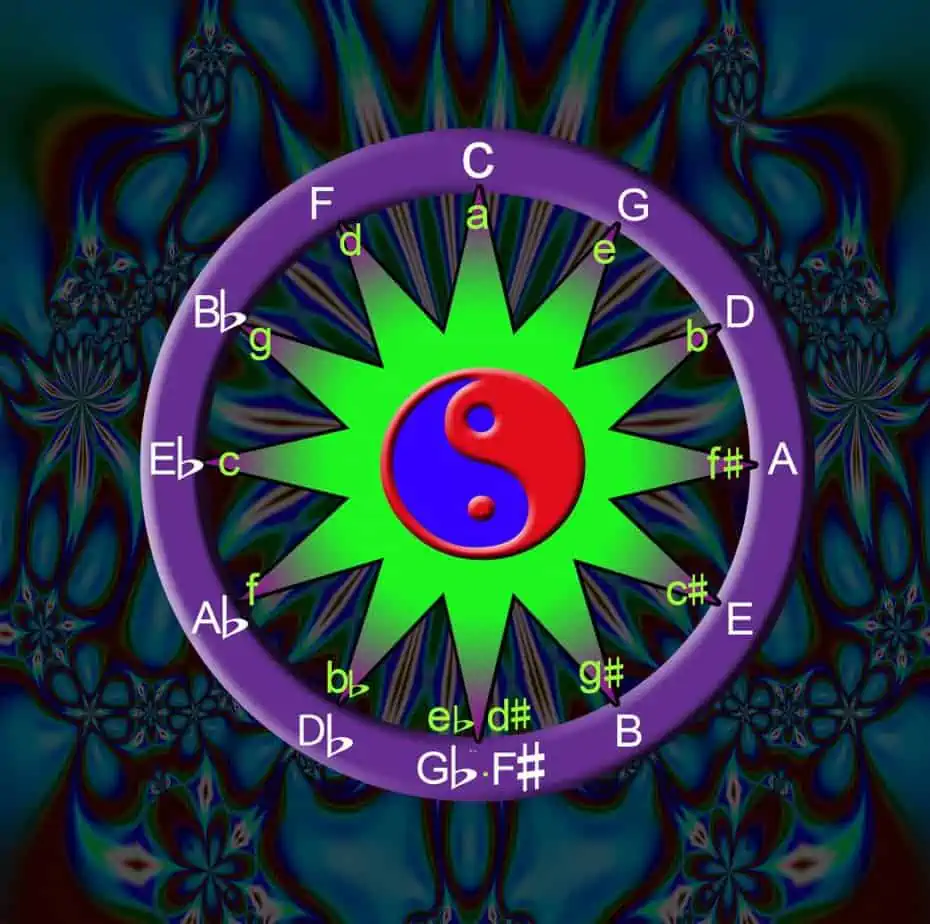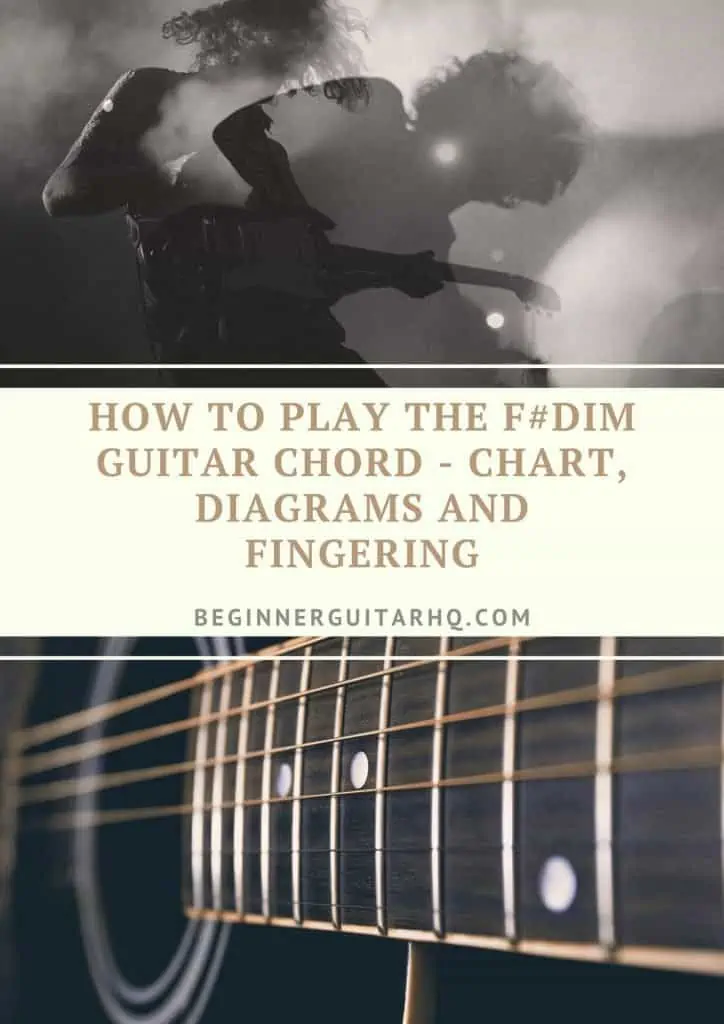F#dim is one of those chords, that in my opinion, doesn’t sound great on its own. But when used in the right way, it adds a dark kind of tension that adds some drama to a song. Usually, it’s used as a bridge between two other chords so that the tension resolves. But because of the way they sound, you might be wondering if you’re even playing them correctly and they can seem complicated to play. However, there are a couple of different ways to play F#dim. You can choose which works for you or sounds best in your songs.
What is a Diminished Chord and F#dim in Particular?
A diminished chord has a flattened third and a flattened fifth (1 3♭ 5♭). It’s the minor third that gives it some sadness, but the addition of a diminished fifth adds some dissonance that turns the chord into something dark and dramatic.
We can determine the notes in F#dim by using the F# major scale:
F#, G#, A#, B, C#, D#, E#, F#
1 2 3 4 5 6 7 8
You take the first interval, F#, the third (A#), which you flatten to become A, and then the fifth interval (C#) which you flatten to become C.
F# A C
You will always be able to figure out what the major scale is by using the circle of fifths and using the formula for a diminished chord, you’ll always be able to figure out your diminished chords.
You can of course write F# diminished as F#dim as I have been, or you can write it as F#o.
How to Use the F#dim Chord
As mentioned, diminished chords are used as a bridge. You always need to resolve diminished chords unless you like leaving your music on a really unfinished tension inducing note. This is because diminished chords aren’t in the key that you’re playing in. You will need to make the chord after F#dim either a major or minor.
G is a good choice in terms of a major chord. So is Gm for the minor chord. The idea is to resolve it to a major or minor chord a half step higher.
You won’t often find a diminished chord in the first or last bar of a song, but if that’s what you want to do, let your creativity flow where it wants to as long as it sounds good. You can put it anywhere in your chord progression, but remember, the diminished chord doesn’t stick around long. The point of a passing chord is to make it like a quick stepping stone to the next chord.
How to Play the F#dim Guitar Chord
As mentioned, there are a few ways to play the F#dim chord on the guitar.
Three Note Versions
All these chords just take 3 fingers and tend to sound a little higher in general as they don’t include the bass strings in most cases.
F#dim Version 1
This version is quite a low voicing, and is good with open chords and E-shape barre chords. The same goes if you’re playing the lower voicings of jazz chords.
The strings you need to avoid playing are simple enough to avoid if you’re playing fingerstyle, otherwise you can angle your fingers to mute the strings. If you accidentally play the 5th string, it isn’t a train smash since it’s the A string. It will add some bass. But the other strings should be avoided as they are D (4th string) and E (1st string), which aren’t in F#dim.
Index finger: 2nd string, 1st fret
Middle finger: 6th string, 2nd fret
Ring finger: 3rd string, 2nd fret
F#dim Version 2
This is also lower voicing, but because the F# is in the 4th fret on the 4th (D) string, it doesn’t have that bassy tone that the previous version has. Somehow, it has a sweeter sound. Again, just try to angle your hand to avoid playing the high E string (1st) and as for the 5th and 6th string, you can try to use your thumb, but otherwise, it just takes a bit of practice to avoid playing them.
Index finger: 2nd string, 1st fret
Middle finger: 3rd string, 2nd fret
Ring or pinky finger: 4th string, 4th fret
F#dim Version 3
This is one of the easiest versions to play since there are no strings to skip in between if you’re strumming. It has a higher tone given that it’s played on the first three strings, despite being played all the way at the top of the neck.
Index finger: 2nd string, 1st fret
Middle finger: 3rd string, 2nd fret
Ring or finger: 1st string, 2nd fret
F#dim Version 4
Naturally, as we’re getting higher up the neck, the voicings are getting higher. This chord will sound great if you’re playing with another guitarist who’s playing open chords at the top of the fretboard.
Index finger: 4th string, 4th fret
Middle finger: 3rd string, 5th fret
Ring finger: 1st string, 5th fret
F#dim Version 5
This version is quite a stretch. If you have smaller hands or shorter fingers, you may have to change your fingering a little. If you can’t manage it though, don’t worry about it, just play one of the other versions instead.
Index finger: 3rd string, 5th fret
Middle or ring finger: 4th string, 7th fret
Ring or pinky finger: 5th string, 9th fret
F#dim Version 6
This version has some extra drama to it in my opinion. You’ve got the 4th string adding in more of a bassy tone, albeit not as low as you would get on strings 5 and 6, but it’s still somewhat high-pitched, giving it that extra bit of drama.
Index finger: 3rd string, 5th fret
Middle or ring finger: 4th string, 7th fret
Ring or pinky finger: 2nd string, 7th fret
F#dim Version 7
This is another easy one to play in terms of if you’re strumming with a pick. Again, it’s a higher voicing given that it’s played on the first three strings.
Index finger: Barre strings 1-3 in the 5th fret
Ring or pinky finger: 2nd string, 7th fret
F#dim Version 8
Although it may look intimidating for people with smaller hands due to the four fret stretch, it’s actually not that bad. The frets become smaller higher up on the neck. I feel like this version has a bit of sweetness to it due to the higher pitch.
Index finger: 1st string, 8th fret
Middle or ring finger: 2nd string, 10th fret
Ring or pinky finger: 3rd string, 11th fret
F#dim Version 9
While this might sound weird, I feel this version has a questioning tone. Music tends to be subjective in many ways, so you might feel it says something different.
Index finger: 5th string, 9th fret
Middle finger: 4th string, 10th fret
Ring finger: 2nd string, 10th fret
F#dim Version 10
This high voicing will go well played with chords of a lower voicing. If you’re playing the same thing as another guitarist, playing this higher voicing over their lower voicing adds intricacy and spices up the music.
Index finger: 4th string, 10th fret
Middle finger: 2nd string, 10th fret
Ring finger: 3rd string, 11th fret
Four Note Versions
Often these chords have a little more depth to them thanks to the addition of some bass.
F#dim Version 11
Personally, I find this chord a lot easier to play when I use my thumb on the 6th string (low E). If you play the rest of the chord with your index, ring, and pinky fingers, you can use your middle finger to mute the 4th string.
Index finger or thumb: 2nd string, 1st fret
Middle or index finger: 6th string, 2nd fret
Ring or middle finger: 3rd string, 2nd fret
Pinky or ring finger: 1st string, 2nd fret
F#dim Version 12
This is a very low voicing compared to most of the versions. Use it if you want a darker sound or if you’re playing with another guitarist who’s playing the higher voicings.
Index finger: Barre strings 3-6 (or the whole second fret )
Middle finger: 5th string, 3rd fret
Ring finger: 4th string, 4th fret
F#dim Version 13
This version can feel awkward, especially if you have smaller hands and/or shorter fingers. But angle your hand and wrist as needed, and just practice.
Index finger: 6th string, 2nd fret
Middle finger: 4th string, 4th fret
Ring finger: 3rd string, 5th fret
Pinky finger: 1st string, 5th fret
F#dim Version 14
This version is another very awkward one. If your hand is anything like mine (on the smaller side), this may be a version that isn’t meant for you. But, for some of you, it may just take getting creative and some practice, and voila!
Index finger: 6th string, 2nd fret
Middle finger: 1st string, 2nd fret
Ring finger: 4th string, 4th fret
Pinky finger: 3rd string, 5th fret
F#dim Version 15
Barring the second fret can help you with muting the second string if you angle your finger right. Just be careful not to play the second string as pressing the string down in the second fret results in a C# and open it’s a B.
Index finger: Barre strings 3-6 in the 2nd fret, alternatively, barre the whole 2nd fret
Middle finger: 5th string, 3rd fret
Ring finger: 4th string, 4th fret
Pinky finger: 1st string, 5th fret
F#dim Version 16
This version is all about getting the angle right.
Index finger: 4th string, 4th fret
Middle finger: 3rd string, 5th fret
Ring finger: 1st string, 5th fret
Pinky finger: 2nd string, 7th fret
F#dim Version 17
Again, it’s all about the angle with this one. If you can get it right, it’s a slightly sweeter sounding one without being too high pitched.
Index finger: 4th string, 7th fret
Middle finger: 1st string, 8th fret
Ring finger: 5th string, 9th fret
Pinky finger: 2nd string, 10th fret
F#dim Version 18
This one is more for those of you with acrobatically inclined fingers.
Index finger: 4th string, 7th fret
Middle finger: 2nd string, 7th fret
Ring finger: 1st string, 8th fret
Pinky finger: 5th string, 9th fret
F#dim Version 19
This version is beautiful. Slightly higher pitched, with a teensy bit of bass to balance it out.
Index finger: 1st string, 8th fret
Middle finger: 5th string, 9th fret
Ring finger: 4th string, 10th fret
Pinky finger: 2nd string, 10th fret
F#dim Version 20
This is easy enough to play if you have a cutaway guitar. For the rest of us, it’s doable, but you need to angle your hand just right to play this chord. While this is high-pitched, it’s balanced because of the use of the 5th and 6th strings.
Index finger: Barre the 14th fret
Middle finger: 5th string, 15th fret
Ring finger: 4th string, 16th fret
F#dim Version 21
This version is quite difficult if you don’t have a cutaway guitar.
Index finger: Barre the 14th fret
Middle finger: 5th string, 15th fret
Ring finger: 4th string, 16th fret
F#dim Version 22
Every type of guitar is okay for this version since it’s much easier to barre the fret and then just pop your middle finger onto the 5th string. No weird angles required.
Index finger: Barre the 14th fret
Middle finger: 5th string, 15th fret
F#dim Version 23
This is a well-rounded version of the chord. High-pitched with some bass. But it’s tough tp play on a guitar that isn’t a cutaway.
Index finger: Barre the 14th fret
Middle finger: 5th string,15th fret
Ring or pinky finger: 1st string, 17th fret
Conclusion
Well there you have it. 23 different ways to play F#dim. What may seem like a complicated chord is actually fairly easy to play depending on which version of the chord your pick. It’s great to get to know a couple of different ways in different voicings so you can play with different people. It’s also good for unleashing your creativity. You can match the chords to different genres or whatever sound you’re going for.
Just keep practicing if you’re struggling. And if you find that you can’t play certain versions no matter which fingers you use, or how you angle your hand, or how hard you practice, just move on. That’s the best thing about having so many ways to play the chord. There’s a version of this chord suitable for everyone.
Happy jamming!

























